For more detailed information on the following list of plants you will find on your walk, please take a look at the Plant Walk document (PDF) or click the more information links provided for each plant. Both the document and the links provide pictures, scientific classification, habitat, and uses (past and present) of these plants. A list of references is also included in the document or available at this link.
American Elm (Ulmus americana)
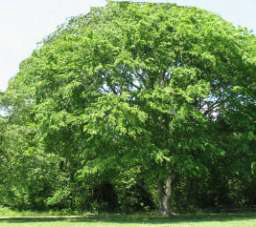 Characteristics: The American Elm is a deciduous tree, sometimes growing to more than 100 feet tall with a trunk 4 feet or more in diameter. The crown forms a high, spreading canopy. The leaves are alternate, 2.5 to 4 inches long, with sharply serrate edges, and an oblique base. The flowers are small, purple-brown, and have no petals because they are wind-pollinated; the flowers emerge in early spring before the leaves. The tree is capable of self-pollination because the flowers each have both male and female parts. More information...
Characteristics: The American Elm is a deciduous tree, sometimes growing to more than 100 feet tall with a trunk 4 feet or more in diameter. The crown forms a high, spreading canopy. The leaves are alternate, 2.5 to 4 inches long, with sharply serrate edges, and an oblique base. The flowers are small, purple-brown, and have no petals because they are wind-pollinated; the flowers emerge in early spring before the leaves. The tree is capable of self-pollination because the flowers each have both male and female parts. More information...
American Holly (Ilex opaca)
 Characteristics: The American Holly is a narrow, rounded tree that can grow to between 40 and 70 feet in height. The diameter ranges from 1 to 2 feet. The bark is smooth and grayish in color. The American Holly is most easily recognized by its evergreen, thick, spiny leaves. In the spring it produces small white flowers and in the fall forms bright red berries that last through the winter. Many songs and game birds eat the bitter berries, helping to spread the seeds. More information...
Characteristics: The American Holly is a narrow, rounded tree that can grow to between 40 and 70 feet in height. The diameter ranges from 1 to 2 feet. The bark is smooth and grayish in color. The American Holly is most easily recognized by its evergreen, thick, spiny leaves. In the spring it produces small white flowers and in the fall forms bright red berries that last through the winter. Many songs and game birds eat the bitter berries, helping to spread the seeds. More information...
American Sycamore (Platanus occidentalis)
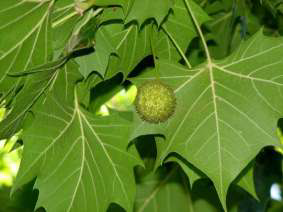 Characteristics: None listed. More information...
Characteristics: None listed. More information...
Arrow Arum (Tuckahoe)
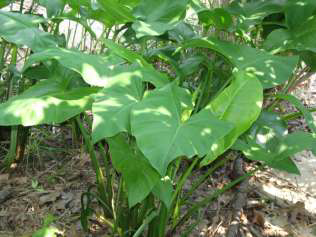 Characteristics: Arrow arum leaves are arrowhead-shaped and are typically 10 to 12 inches long and 5 to 6 inches wide. The leaf underside is whitish with three prominent veins. Its leaves are clustered on long succulent stalks that can be up to three feet long. Arrow arum flowers are small and light yellow, on a fingerlike spike. The flower spike is surrounded by a bract or spathe, that is usually yellowish-green. The fruits are primarily dispersed by water, although animals also play a role. More information...
Characteristics: Arrow arum leaves are arrowhead-shaped and are typically 10 to 12 inches long and 5 to 6 inches wide. The leaf underside is whitish with three prominent veins. Its leaves are clustered on long succulent stalks that can be up to three feet long. Arrow arum flowers are small and light yellow, on a fingerlike spike. The flower spike is surrounded by a bract or spathe, that is usually yellowish-green. The fruits are primarily dispersed by water, although animals also play a role. More information...
Black Walnut (Juglans nigra L.)
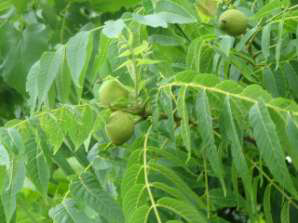 Characteristics: The Black Walnut is a deciduous tree reaching heights of 100 to 130 feet tall. The bark is grey-black and deeply furrowed. The leaves are alternate and odd-pinnately compound with 15–23 leaflets. The flowers are small and greenish, appearing in the early spring with male and female flowers on separate stalks. In the autumn they mature into a fruit with a brownish-green, semifleshy husk and a brown corrugated nut. The whole fruit, including the husk, falls in October; the seed is relatively small and very hard. More information...
Characteristics: The Black Walnut is a deciduous tree reaching heights of 100 to 130 feet tall. The bark is grey-black and deeply furrowed. The leaves are alternate and odd-pinnately compound with 15–23 leaflets. The flowers are small and greenish, appearing in the early spring with male and female flowers on separate stalks. In the autumn they mature into a fruit with a brownish-green, semifleshy husk and a brown corrugated nut. The whole fruit, including the husk, falls in October; the seed is relatively small and very hard. More information...
Broadleaf Cattail (Typha latifolia L.)
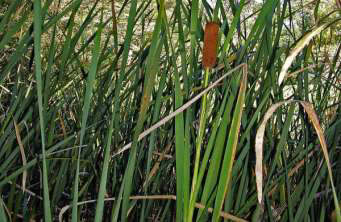 Characteristics: The broadleaf cattail is typically 1 to 7 meters tall, with spongy, strap-like leaves and starchy, creeping stems. The leaves are alternate and mostly basal to a simple, jointless stem that bears the flowers at the top. The rhizomes spread horizontally beneath the surface of muddy ground to start new upright growth. The male flower spike develops at the top of the vertical stem, above the female flower spike. The male flowers are reduced to a pair of stamens and hairs and wither once the pollen is shed, leaving a short, and bare stem portion above the female inflorescence. The dense cluster of female flowers forms a cylindrical spike 10 to as much as 40 centimeters long and 1 to 4 centimeters wide. Broad leaf cattails are monoecious, wind-pollinated, and bear unisexual flowers developing in dense, complex spikes. The seeds are attached to a thin hair or stalk, which aids in wind dispersal. More information...
Characteristics: The broadleaf cattail is typically 1 to 7 meters tall, with spongy, strap-like leaves and starchy, creeping stems. The leaves are alternate and mostly basal to a simple, jointless stem that bears the flowers at the top. The rhizomes spread horizontally beneath the surface of muddy ground to start new upright growth. The male flower spike develops at the top of the vertical stem, above the female flower spike. The male flowers are reduced to a pair of stamens and hairs and wither once the pollen is shed, leaving a short, and bare stem portion above the female inflorescence. The dense cluster of female flowers forms a cylindrical spike 10 to as much as 40 centimeters long and 1 to 4 centimeters wide. Broad leaf cattails are monoecious, wind-pollinated, and bear unisexual flowers developing in dense, complex spikes. The seeds are attached to a thin hair or stalk, which aids in wind dispersal. More information...
Common Greenbrier (Smilax rotundifolia L.)
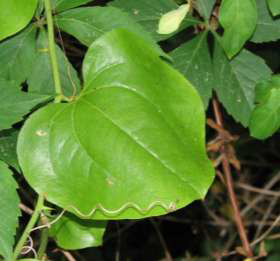 Characteristics: Common Greenbrier is a woody vine that climbs other plants using green tendrils growing out of its petioles. The leaves are glossy green, alternate, and circular to heart-shaped. They are generally 5-13 centimeters long. The round stems have sharp prickles growing on them. The flowers are greenish, and the fruit are bluish black berries. Common greenbrier produces fruit every year. Seeds are dispersed by animals and water. The flowers are seen from April to August, and the fruit becomes ripe in September. More information...
Characteristics: Common Greenbrier is a woody vine that climbs other plants using green tendrils growing out of its petioles. The leaves are glossy green, alternate, and circular to heart-shaped. They are generally 5-13 centimeters long. The round stems have sharp prickles growing on them. The flowers are greenish, and the fruit are bluish black berries. Common greenbrier produces fruit every year. Seeds are dispersed by animals and water. The flowers are seen from April to August, and the fruit becomes ripe in September. More information...
Common Milkweed (Asclepias syriaca L.)
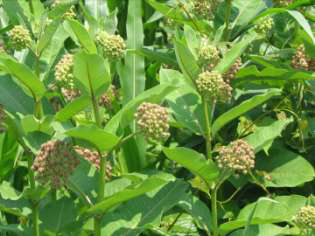 Characteristics: The common milkweed is a tall downy plant, ranging 2 to 6 feet in height. It has purple to pink flower clusters, which are approximately 2 inches wide and appear in the spring. The leaves are opposite and 4 to 10 inches in length; they are light green with grayish down beneath and produce a milky sap when damaged. The seed pods are rough in texture, opening along the side, and producing overlapping seeds with tufts of silky hairs. More information...
Characteristics: The common milkweed is a tall downy plant, ranging 2 to 6 feet in height. It has purple to pink flower clusters, which are approximately 2 inches wide and appear in the spring. The leaves are opposite and 4 to 10 inches in length; they are light green with grayish down beneath and produce a milky sap when damaged. The seed pods are rough in texture, opening along the side, and producing overlapping seeds with tufts of silky hairs. More information...
Dandelion (Taraxacum officinale Web.)
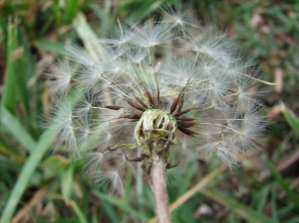 Characteristics: The Dandelion has leaves that are 5 to 25 inches long and are simple and basal. The leaves can be either entire or lobed. The leaves form a rosette above the central taproot. A bright yellow flower head (which is open in the daytime but closes at night) is borne singly on a hollow stem which rises 1.5 to 11 inches above the leaves and exudes a milky sap when broken. One rosette may produce several flowering stems at a time. The flower head is 1 to 2 inches in diameter and consists entirely of ray florets. The inner bracts are erect until the seeds mature, then flex down to allow the seeds to disperse. As the leaves grow outward they kill the surrounding vegetation by cutting off the sunlight. The dandelion flower matures into a globe of fine filaments that are distributed by wind. More information...
Characteristics: The Dandelion has leaves that are 5 to 25 inches long and are simple and basal. The leaves can be either entire or lobed. The leaves form a rosette above the central taproot. A bright yellow flower head (which is open in the daytime but closes at night) is borne singly on a hollow stem which rises 1.5 to 11 inches above the leaves and exudes a milky sap when broken. One rosette may produce several flowering stems at a time. The flower head is 1 to 2 inches in diameter and consists entirely of ray florets. The inner bracts are erect until the seeds mature, then flex down to allow the seeds to disperse. As the leaves grow outward they kill the surrounding vegetation by cutting off the sunlight. The dandelion flower matures into a globe of fine filaments that are distributed by wind. More information...
Devil’s Walking Stick (Aralia spinosa L.)
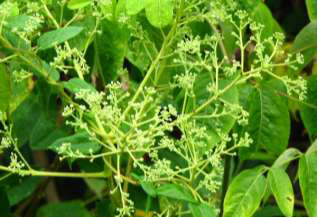 Characteristics: Aralia spinosa, known as Devil’s Walking Stick, is a spiny shrub or sometimes a small tree. The twigs are very thick, light brown colored, and covered with many straight sharp spines, especially at the nodes. The bipinnately compound leaves are 16 to 30 inches long and clustered at the ends of the twigs. The leaflets are numerous and are mostly paired; they are ovate to broadly elliptical in shape, and 2 to 3.5 inches long, with finely serrated edges. The leaflets are dark green above and lighter below, often with prickles on the mid-vein on the underside. The small white flowers have 5 petals in a large cluster 8 to16 inches long. Devil’s Walking Stick flowers in the summer and the fruits, numerous black drupes about 0.25 inches in diameter, mature in late fall. It propagates by sprouting from the roots to form cloned thickets. More information...
Characteristics: Aralia spinosa, known as Devil’s Walking Stick, is a spiny shrub or sometimes a small tree. The twigs are very thick, light brown colored, and covered with many straight sharp spines, especially at the nodes. The bipinnately compound leaves are 16 to 30 inches long and clustered at the ends of the twigs. The leaflets are numerous and are mostly paired; they are ovate to broadly elliptical in shape, and 2 to 3.5 inches long, with finely serrated edges. The leaflets are dark green above and lighter below, often with prickles on the mid-vein on the underside. The small white flowers have 5 petals in a large cluster 8 to16 inches long. Devil’s Walking Stick flowers in the summer and the fruits, numerous black drupes about 0.25 inches in diameter, mature in late fall. It propagates by sprouting from the roots to form cloned thickets. More information...
Eastern Redcedar (Red Juniper)
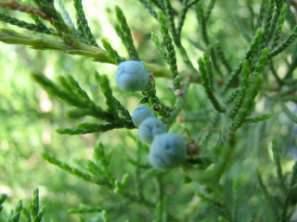 Characteristics: Eastern Redcedar is an evergreen, aromatic tree with a trunk that is often angled and slightly wider at the base, but with a narrow, compact crown that sometimes becomes broad and irregular. It grows to heights ranging from 40 to 60 feet with a trunk diameter of 1 to 2 feet. However, in poor soil, it may never become more than a shrub. The leaves are evergreen and opposite in 4 rows forming
slender quadrangle twigs. The bark is reddish-brown, thin, fibrous, and shreds easily. The cones are small, approximately 1/4 to 3/8 of an inch in diameter and are berry-like in appearance. The pollen cones are
on separate trees from the berries. More information...
Characteristics: Eastern Redcedar is an evergreen, aromatic tree with a trunk that is often angled and slightly wider at the base, but with a narrow, compact crown that sometimes becomes broad and irregular. It grows to heights ranging from 40 to 60 feet with a trunk diameter of 1 to 2 feet. However, in poor soil, it may never become more than a shrub. The leaves are evergreen and opposite in 4 rows forming
slender quadrangle twigs. The bark is reddish-brown, thin, fibrous, and shreds easily. The cones are small, approximately 1/4 to 3/8 of an inch in diameter and are berry-like in appearance. The pollen cones are
on separate trees from the berries. More information...
Flowering Dogwood (Cornus florida L.)
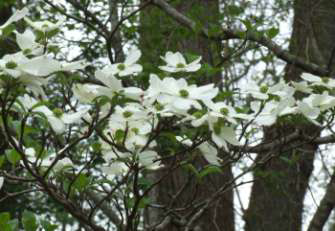 Characteristics: The Flowering Dogwood is a relatively small tree, reaching heights of 30 feet and trunk diameters of 8 inches. The rough bark is a reddish-brown color. The leaves are opposite and elliptical, approximately 2.5 to 5 inches long and 1.5 to 2.5 inches wide, with slightly wavy edges. The flowers are 3/8 of an inch in diameter and are greenish-yellow. These are surrounded by four white petal-like bracts, approximately 1.5 inches long. The bright red, berry-like fruit form in clusters and are about 3/8 to 5/8 of an inch in diameter. More information...
Characteristics: The Flowering Dogwood is a relatively small tree, reaching heights of 30 feet and trunk diameters of 8 inches. The rough bark is a reddish-brown color. The leaves are opposite and elliptical, approximately 2.5 to 5 inches long and 1.5 to 2.5 inches wide, with slightly wavy edges. The flowers are 3/8 of an inch in diameter and are greenish-yellow. These are surrounded by four white petal-like bracts, approximately 1.5 inches long. The bright red, berry-like fruit form in clusters and are about 3/8 to 5/8 of an inch in diameter. More information...
Jewelweed (Impatiens capensis Meerb.)
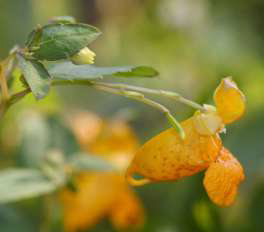 Characteristics: Jewelweed is an annual with leaves that are somewhat triangular in shape with toothed margins. The flowers are orange-colored, tubular-shaped, and hooked at one end. The stems are somewhat translucent, but are succulent and have swollen or darkened nodes. The flowers may be found as early as June, but typically bloom in October. The seed pods are pendant shaped and when ripe have projectile seeds that explode out of the pods when they are lightly touched. More information...
Characteristics: Jewelweed is an annual with leaves that are somewhat triangular in shape with toothed margins. The flowers are orange-colored, tubular-shaped, and hooked at one end. The stems are somewhat translucent, but are succulent and have swollen or darkened nodes. The flowers may be found as early as June, but typically bloom in October. The seed pods are pendant shaped and when ripe have projectile seeds that explode out of the pods when they are lightly touched. More information...
Narrow-leaved Cattail (Typha angustifolia)
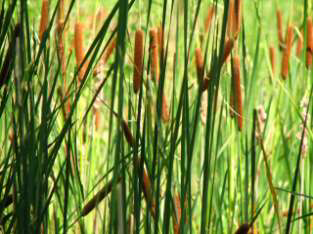 Characteristics: Narrow-leaved Cattail typically grows up 1 to 7 meters tall, with spongy, strap-like leaves and starchy, creeping stems. The jointless stem bears the flowers. The rhizomes spread horizontally beneath the surface of the ground to start new upright growth. The male flowers are reduced to a pair of stamens and hairs and wither once the pollen is shed, leaving a short and bare stem portion above the female inflorescence. The dense cluster of female flowers forms a cylindrical spike some 10 to as much as 40 centimeters long and 1 to 4 centimeters wide. The seeds are very small, only about 0.2 millimeters long. Cattails are monoecious, wind-pollinated, and bear unisex flowers developing in dense, complex spikes. The seeds are attached to thin hair or stalk, which enhances wind dispersal. More information...
Characteristics: Narrow-leaved Cattail typically grows up 1 to 7 meters tall, with spongy, strap-like leaves and starchy, creeping stems. The jointless stem bears the flowers. The rhizomes spread horizontally beneath the surface of the ground to start new upright growth. The male flowers are reduced to a pair of stamens and hairs and wither once the pollen is shed, leaving a short and bare stem portion above the female inflorescence. The dense cluster of female flowers forms a cylindrical spike some 10 to as much as 40 centimeters long and 1 to 4 centimeters wide. The seeds are very small, only about 0.2 millimeters long. Cattails are monoecious, wind-pollinated, and bear unisex flowers developing in dense, complex spikes. The seeds are attached to thin hair or stalk, which enhances wind dispersal. More information...
Pawpaw (Asimina triloba)
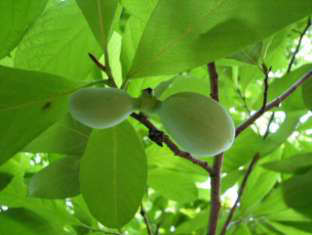 Characteristics: The Pawpaw is a deciduous, often narrowly conical tree growing from about 12 feet to around 20 feet. The dark green, obovate-oblong, drooping leaves grow up to 12 inches long, giving the pawpaw a tropical appearance. The maroon flowers are up to 2 inches across and hang upside-down. They bloom from late March to early May. Each flower contains several ovaries, which explains why a single flower can produce multiple fruits. More information...
Characteristics: The Pawpaw is a deciduous, often narrowly conical tree growing from about 12 feet to around 20 feet. The dark green, obovate-oblong, drooping leaves grow up to 12 inches long, giving the pawpaw a tropical appearance. The maroon flowers are up to 2 inches across and hang upside-down. They bloom from late March to early May. Each flower contains several ovaries, which explains why a single flower can produce multiple fruits. More information...
Persimmon (Diospyros virginiana L.)
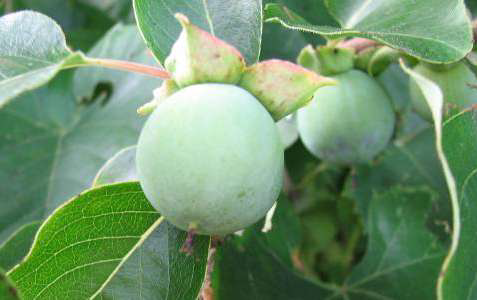 Characteristics: The Persimmon tree has a dense rounded, cylindrical crown, but sometimes grows as a shrub. The leaves are ovate to elliptical shaped, and shiny, dark green above, but whitish and hairless on the bottom. The bark is deeply furrowed, with square-shaped scaly plates. The flowers form in the spring, are small and white with four lobes. The trees are dioecious-- the male and female flowers are on separate trees. Sweet orange fruit is produced in the fall, which is favored by wildlife that spread the seeds. More information...
Characteristics: The Persimmon tree has a dense rounded, cylindrical crown, but sometimes grows as a shrub. The leaves are ovate to elliptical shaped, and shiny, dark green above, but whitish and hairless on the bottom. The bark is deeply furrowed, with square-shaped scaly plates. The flowers form in the spring, are small and white with four lobes. The trees are dioecious-- the male and female flowers are on separate trees. Sweet orange fruit is produced in the fall, which is favored by wildlife that spread the seeds. More information...
Phragmites (Phragmites australis (Cav.) Trin. ex Steud.)
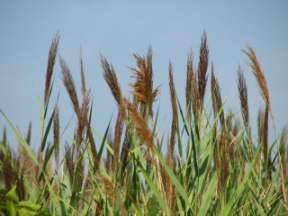 Characteristics: Phragmites, sometimes known as Giant Reed, is a tall thick-stemmed grass. The leaves are flat, sharply pointed and green to bluish in color. Leaves can be up to 20 inches long and 2 inches wide; they are rough-edged, sheathing the stem at the base. It bears spikelets with many silky hairs in large terminal clusters that are initially reddish colored but change to silver. Phragmites is invasive and has replaced extensive regions of tidal marshes. It rarely produces seeds, rather spreads horizontally through rhizomes over the surface of the ground. It can form dense stands that exclude all other species. More information...
Characteristics: Phragmites, sometimes known as Giant Reed, is a tall thick-stemmed grass. The leaves are flat, sharply pointed and green to bluish in color. Leaves can be up to 20 inches long and 2 inches wide; they are rough-edged, sheathing the stem at the base. It bears spikelets with many silky hairs in large terminal clusters that are initially reddish colored but change to silver. Phragmites is invasive and has replaced extensive regions of tidal marshes. It rarely produces seeds, rather spreads horizontally through rhizomes over the surface of the ground. It can form dense stands that exclude all other species. More information...
Poison Ivy (Toxicodendron radicans (L.) Kuntze)
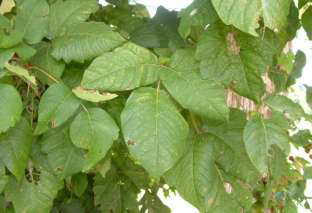 Characteristics: Poison ivy leaves consist of three almond-shaped leaflets. The color ranges from light green to dark green, turning bright red in fall. The leaflets are 3-12 cm long, rarely up to 30 cm and the leaf surface is smooth. The berries are green but turn a grayish-white color. The plants can grow as a shrub up to about 4 ft tall, as a groundcover 4-10 in high, or as a climbing vine on various supports. Older vines on substantial supports send out lateral branches that may at first be mistaken for tree limbs. Birds and mammals disperse the fruits. Unconsumed fruits are retained on the plant through winter and are deposited beneath the parent plant in spring. Vegetative expansion by rhizome is a major mode of reproduction in established plants. More information...
Characteristics: Poison ivy leaves consist of three almond-shaped leaflets. The color ranges from light green to dark green, turning bright red in fall. The leaflets are 3-12 cm long, rarely up to 30 cm and the leaf surface is smooth. The berries are green but turn a grayish-white color. The plants can grow as a shrub up to about 4 ft tall, as a groundcover 4-10 in high, or as a climbing vine on various supports. Older vines on substantial supports send out lateral branches that may at first be mistaken for tree limbs. Birds and mammals disperse the fruits. Unconsumed fruits are retained on the plant through winter and are deposited beneath the parent plant in spring. Vegetative expansion by rhizome is a major mode of reproduction in established plants. More information...
Red Maple (Acer rubrum L.)
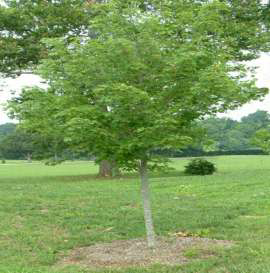 Characteristics: The Red Maple tree has a rounded and compact crown. It reaches heights of 60 to 90 feet with an average trunk diameter of 2.5 feet. The bark is gray, thin and smooth, developing into long scaly ridges as the tree matures. The leaves are 2.5 to 4 inches in length and broadly ovate, with 3 shallow short-pointed lobes. The edges are wavy, serrated and have a long red or green leaf stalk. The leaves are dull green above and whitish and hairy beneath. The fruit is ¾ to 1 inch long. They have a long wing and contain one seed. The long wing aids in wind-disseminated seed dispersal. More information...
Characteristics: The Red Maple tree has a rounded and compact crown. It reaches heights of 60 to 90 feet with an average trunk diameter of 2.5 feet. The bark is gray, thin and smooth, developing into long scaly ridges as the tree matures. The leaves are 2.5 to 4 inches in length and broadly ovate, with 3 shallow short-pointed lobes. The edges are wavy, serrated and have a long red or green leaf stalk. The leaves are dull green above and whitish and hairy beneath. The fruit is ¾ to 1 inch long. They have a long wing and contain one seed. The long wing aids in wind-disseminated seed dispersal. More information...
Red Oak (Quercus rubra L.)
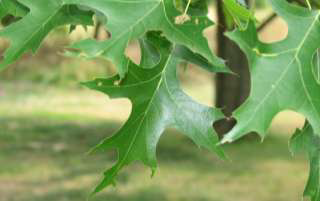 Characteristics: The Red Oak is a large tree with a rounded crown of stout, spreading branches. It ranges from 60 to 90 feet in height and the diameter of the trunk ranges from 1 to 2.5 feet. The bark is dark gray or blackish, rough, and furrowed in scaly ridges, with reddish inner bark. The egg-shaped acorns of this species range from 5/8 to 1 1/8 inches in length. Less than a third of the acorn is enclosed by a broad cup of reddish-brown, blunt, tightly overlapping scales. The acorns mature in their second year. More information...
Characteristics: The Red Oak is a large tree with a rounded crown of stout, spreading branches. It ranges from 60 to 90 feet in height and the diameter of the trunk ranges from 1 to 2.5 feet. The bark is dark gray or blackish, rough, and furrowed in scaly ridges, with reddish inner bark. The egg-shaped acorns of this species range from 5/8 to 1 1/8 inches in length. Less than a third of the acorn is enclosed by a broad cup of reddish-brown, blunt, tightly overlapping scales. The acorns mature in their second year. More information...
Swamp Rose Mallow (Hibiscus moscheutos Welw. ex Hiern.)
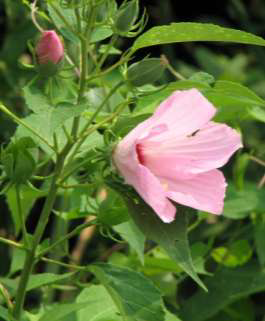 Characteristics: The Swamp Rose Mallow is a multi-stemmed, shrub-like, herbaceous perennial. It can grow up to 7 feet tall. The leaves are usually 2 to 3 inches wide by 6 to 8 inches long,
velvety to the touch on the underside and smooth on top. The flowers are about 6 inches in diameter, with white or pink petals and crimson centers. The swamp-rose mallow dies back in winter and re-sprouts in the spring. It reproduces via seeds or root division. More information...
Characteristics: The Swamp Rose Mallow is a multi-stemmed, shrub-like, herbaceous perennial. It can grow up to 7 feet tall. The leaves are usually 2 to 3 inches wide by 6 to 8 inches long,
velvety to the touch on the underside and smooth on top. The flowers are about 6 inches in diameter, with white or pink petals and crimson centers. The swamp-rose mallow dies back in winter and re-sprouts in the spring. It reproduces via seeds or root division. More information...
Sweet Gum (Liquidambar styraciflua L.)
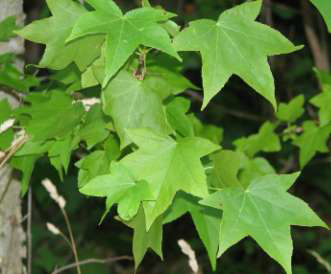 Characteristics: Sweet Gum is a large, aromatic tree with a straight trunk and gray, deeply furrowed, scaly bark. The tree can grow to heights ranging from 60 to 100 feet. The leaves are 3 to 6
inches long and wide. They are star-shaped and have 5, or sometimes 7, deep, finely toothed lobes. In the spring, greenish ball-like clusters of flowers form with the male flowers in clusters along the stalk and the female flowers in drooping clusters on the same tree. The sweetgum is probably most easily recognized by its fruit. Approximately 1 inch in diameter, the long-stalked drooping brown ball is actually composed of many individual fruits, ending in 2 long curved prickly points. The seeds mature in the fall and persist through the winter. Habitat: Sweetgum grows well in the moist soils of valleys and lower slopes and mixed woodlands. It is a pioneer species invading clearings and old fields. More information...
Characteristics: Sweet Gum is a large, aromatic tree with a straight trunk and gray, deeply furrowed, scaly bark. The tree can grow to heights ranging from 60 to 100 feet. The leaves are 3 to 6
inches long and wide. They are star-shaped and have 5, or sometimes 7, deep, finely toothed lobes. In the spring, greenish ball-like clusters of flowers form with the male flowers in clusters along the stalk and the female flowers in drooping clusters on the same tree. The sweetgum is probably most easily recognized by its fruit. Approximately 1 inch in diameter, the long-stalked drooping brown ball is actually composed of many individual fruits, ending in 2 long curved prickly points. The seeds mature in the fall and persist through the winter. Habitat: Sweetgum grows well in the moist soils of valleys and lower slopes and mixed woodlands. It is a pioneer species invading clearings and old fields. More information...
Trumpet Vine (Campsis radicans (L.)
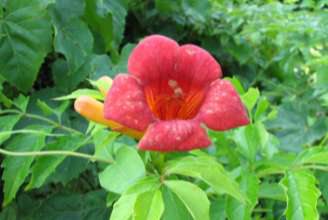 Characteristics: The Trumpet Vine is a woody vine with trumpet-shaped red-orange to yellowish flowers. The vine is generally 20 feet in length but can be larger. The flowers are approximately 2.5 inches in length and from July through September. The leaves are pinnately compound, composed of 7 to 9 leaflets. The fruit is borne in a capsule ranging from 5 to 7
inches in length. The vine climbs or spreads over the ground by means of aerial rootlets on the stems which latch on to whatever is located nearby. More information...
Characteristics: The Trumpet Vine is a woody vine with trumpet-shaped red-orange to yellowish flowers. The vine is generally 20 feet in length but can be larger. The flowers are approximately 2.5 inches in length and from July through September. The leaves are pinnately compound, composed of 7 to 9 leaflets. The fruit is borne in a capsule ranging from 5 to 7
inches in length. The vine climbs or spreads over the ground by means of aerial rootlets on the stems which latch on to whatever is located nearby. More information...
Tulip Poplar (Liriodendron tulipifera L)
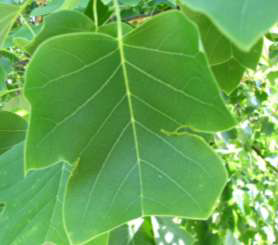 Characteristics: Tulip poplar is a member of the magnolia family. The smooth leaves are tulip-shaped, alternate, and simple. Twigs are moderately stout, olive-brown, to reddish-brown, very smooth and usually lustrous; the large terminal bud has two large duck-bill shaped scales. The bark on younger trunks and branches is quite smooth, light ashy-gray with very shallow, longitudinal, whitish furrows. With age the bark becomes very thick; having deep interlacing furrows and rather narrow rounded ridges. This tree is rapid growing, attaining heights of 80 to 120 feet and a trunk diameter of 2 to 5 feet. Tulip poplar produces tulip-shaped, light greenish-yellow flowers from April to June. The fruit form in cone-shaped clusters. More information...
Characteristics: Tulip poplar is a member of the magnolia family. The smooth leaves are tulip-shaped, alternate, and simple. Twigs are moderately stout, olive-brown, to reddish-brown, very smooth and usually lustrous; the large terminal bud has two large duck-bill shaped scales. The bark on younger trunks and branches is quite smooth, light ashy-gray with very shallow, longitudinal, whitish furrows. With age the bark becomes very thick; having deep interlacing furrows and rather narrow rounded ridges. This tree is rapid growing, attaining heights of 80 to 120 feet and a trunk diameter of 2 to 5 feet. Tulip poplar produces tulip-shaped, light greenish-yellow flowers from April to June. The fruit form in cone-shaped clusters. More information...
Virginia Creeper(Parthenocissus quinquefolia (L.) Planch.)
 Characteristics: Virginia creeper is a perennial plant and a prolific climber, reaching heights of 60 to 100 feet. It climbs smooth surfaces using small forked tendrils tipped with small strongly adhesive pads. The leaves are palmately compound, comprised of five leaflets joined from a central point on the leafstalk, and range from 1 to 8 inches across. The flowers are small and greenish, produced in clusters in the late spring. In the summer or early fall, the fruit form and mature into small hard purplish-black berries. The berries are then eaten and distributed by a wide variety of songbirds. More information...
Characteristics: Virginia creeper is a perennial plant and a prolific climber, reaching heights of 60 to 100 feet. It climbs smooth surfaces using small forked tendrils tipped with small strongly adhesive pads. The leaves are palmately compound, comprised of five leaflets joined from a central point on the leafstalk, and range from 1 to 8 inches across. The flowers are small and greenish, produced in clusters in the late spring. In the summer or early fall, the fruit form and mature into small hard purplish-black berries. The berries are then eaten and distributed by a wide variety of songbirds. More information...
Wild Garlic (Allium vineale L.)
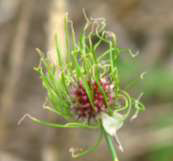 Characteristics: Wild garlic is a perennial herb growing approximately 8 to 12 inches in height. Bright green tubular leaves arise from the main underground bulb in early spring. Later in the season, a few main stalks become large and produce flowers. Greenish-white to lavender, tubular flowers appear from May to July and are above aerial bulblets. Aerial bulblets at the top of the stem are oval, smooth with shiny covering and will often sprout while still on the plant. The seeds are black, flat on one side and about 1/8 inch long. The root system consists of short, fibrous roots developing from the bottom of underground bulbs. The plants have a strong garlic or onion odor when crushed. It reproduces from seed, aerial bulblets, and bulbs. The flowers are hermaphrodite and are pollinated by insects. More information...
Characteristics: Wild garlic is a perennial herb growing approximately 8 to 12 inches in height. Bright green tubular leaves arise from the main underground bulb in early spring. Later in the season, a few main stalks become large and produce flowers. Greenish-white to lavender, tubular flowers appear from May to July and are above aerial bulblets. Aerial bulblets at the top of the stem are oval, smooth with shiny covering and will often sprout while still on the plant. The seeds are black, flat on one side and about 1/8 inch long. The root system consists of short, fibrous roots developing from the bottom of underground bulbs. The plants have a strong garlic or onion odor when crushed. It reproduces from seed, aerial bulblets, and bulbs. The flowers are hermaphrodite and are pollinated by insects. More information...
Wild White Clover (Trifolium repens L.)
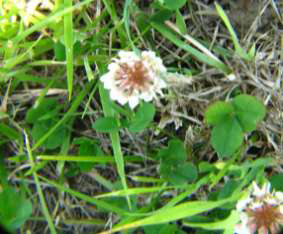 Characteristics: The white clover plant has compound leaves divided into three leaflets which are all joined at a central point and originate at the nodes along the stems. The flowers are an aggregate of 20 to 40 individual flowers. They are white in color, although some have a slight pink tint. White clover flowers from May through September. It is a perennial and reproduces primarily by seed and occasionally creeping stems. More information...
Characteristics: The white clover plant has compound leaves divided into three leaflets which are all joined at a central point and originate at the nodes along the stems. The flowers are an aggregate of 20 to 40 individual flowers. They are white in color, although some have a slight pink tint. White clover flowers from May through September. It is a perennial and reproduces primarily by seed and occasionally creeping stems. More information...
Willow Oak (Quercus phellos L.)
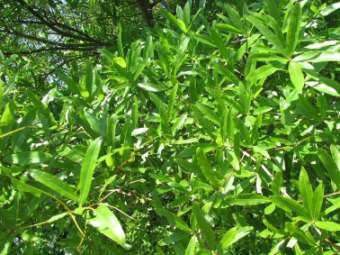 Characteristics: The Willow Oak has a conical or rounded crown with branches ending in very slender, pin-like, twigs with willow-like leaves. It can reach heights of 50 to 80 feet with trunk diameters ranging from 1 to 2 feet. The narrow, oblong leaves have bristles on the end; the edges are straight or only slightly wavy. The bark of younger trees is dark gray and smooth, becoming blackish, irregular, and rough as the tree ages. Brown acorns are produced in the fall every second year. More information...
Characteristics: The Willow Oak has a conical or rounded crown with branches ending in very slender, pin-like, twigs with willow-like leaves. It can reach heights of 50 to 80 feet with trunk diameters ranging from 1 to 2 feet. The narrow, oblong leaves have bristles on the end; the edges are straight or only slightly wavy. The bark of younger trees is dark gray and smooth, becoming blackish, irregular, and rough as the tree ages. Brown acorns are produced in the fall every second year. More information...
Wood Strawberry (Fragaria vesca)
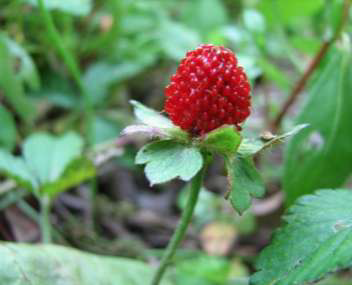 Characteristics: Wood Strawberry plants are 3 to 6 inches in height. They spread by runners. Flowers are white to yellow with five broad petals, and numerous green-yellow stamens, appearing May through August. The fruit appears soon after flowering and is a red berry, which is much smaller in size than our moderngrocery store variety. Its seeds are located on the surface of the fruit, rather than embedded in the skin. The stems and leaves are slightly hairy. The leaves are compound with 3 coarsely toothed leaflets that narrow and are slightly tapered toward the tip. More information...
Characteristics: Wood Strawberry plants are 3 to 6 inches in height. They spread by runners. Flowers are white to yellow with five broad petals, and numerous green-yellow stamens, appearing May through August. The fruit appears soon after flowering and is a red berry, which is much smaller in size than our moderngrocery store variety. Its seeds are located on the surface of the fruit, rather than embedded in the skin. The stems and leaves are slightly hairy. The leaves are compound with 3 coarsely toothed leaflets that narrow and are slightly tapered toward the tip. More information...